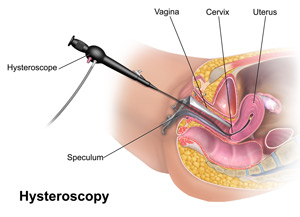
If necessary, an examination of the cervical canal, uterine cavity and uterine tube mouths resorts to hysteroscopy. It is performed by a special device with a hysteroscope. For inspection, the device is inserted into the vagina, then into the cervix and cervical canal. The progress of the study is displayed on the monitor screen.
With the help of hysteroscopy, it is possible not only to examine the patient, but also, for example, to perform scraping of the uterine cavity. This method is very convenient, since it is less traumatic than conventional surgical intervention and occurs completely under visual control. And this means that the procedure will be performed as high as possible, because the doctor has the opportunity to remove all damaged tissues and not to affect healthy.
Benefits of hysteroscopy
- High diagnostic information in the early stages of the development of diseases in the uterine cavity and cervical canal.
- Possibility of examination and surgical intervention in the uterus under visual control.
- Low traumatism.
- Short recovery period.
Indications for hysteroscopy:
- Malignant tumors and benign tumors.
- Adenomyosis of the uterus.
- Endometriosis.
- Endometrial hyperplasia.
- Polyps of the mucous membrane of the cervical canal and endometrium.
Hysteroscopy is divided into diagnostic and operational.
- Diagnostic is used for:
- Setting or confirming a diagnosis.
- Detection and refinement of localization of pathological processes and foreign bodies.
- Operative is used for removal:
- Accretions and anomalies of the uterus.
- Unrepaired by drugs of recurrent bleeding.
- Submocosal myomatous nodes.
Hysteroscopy is usually performed on the 7-9th day of the menstrual cycle, since the thickness of the mucous membrane of the uterus during these days is minimal. If there are indications for the immediate conduct of the procedure, then the day of the cycle does not matter.
To make an appointment with the doctors of the Center for Progressive Medicine «AVICENNA MED» you can call:
+38(096) 290-03-95

